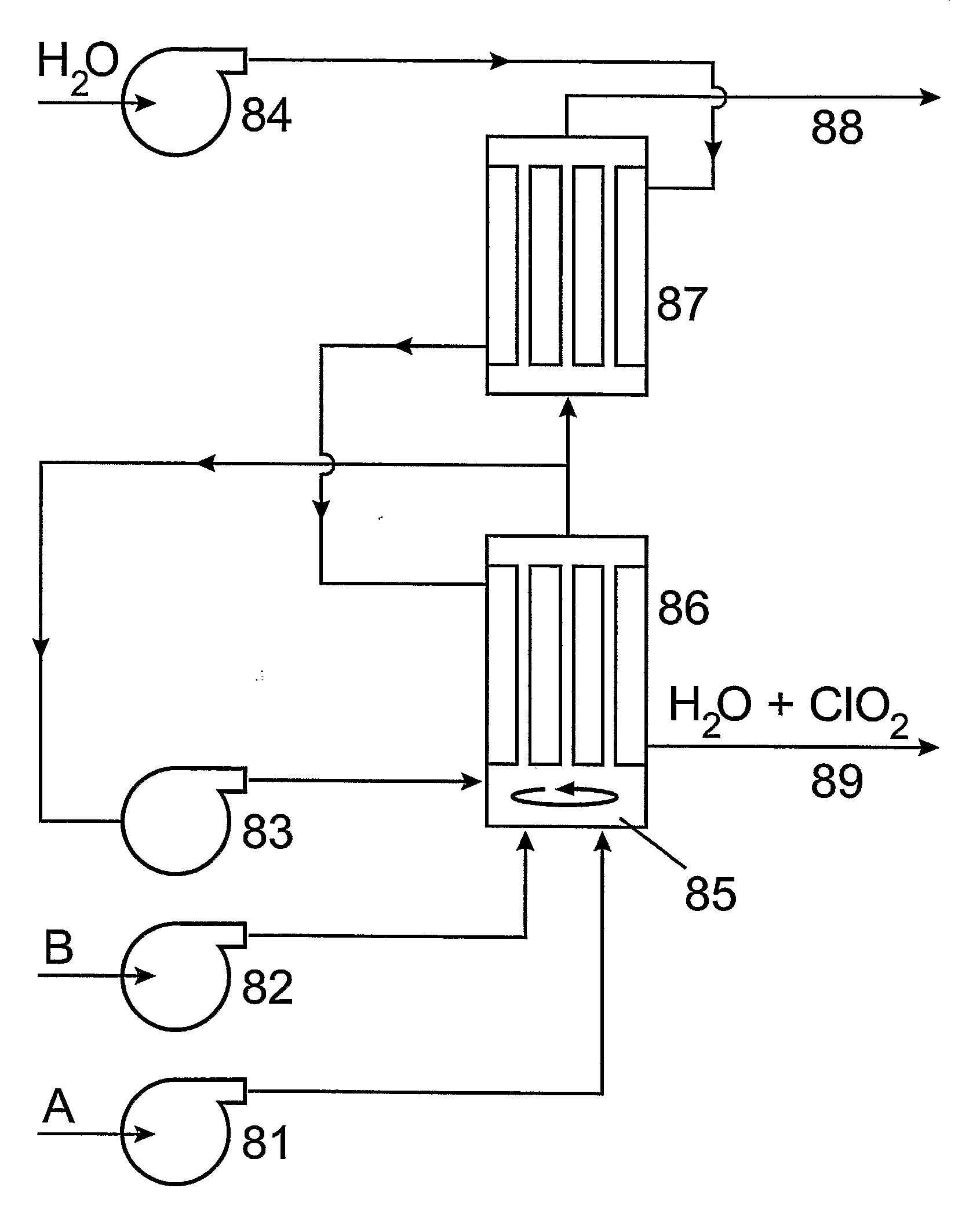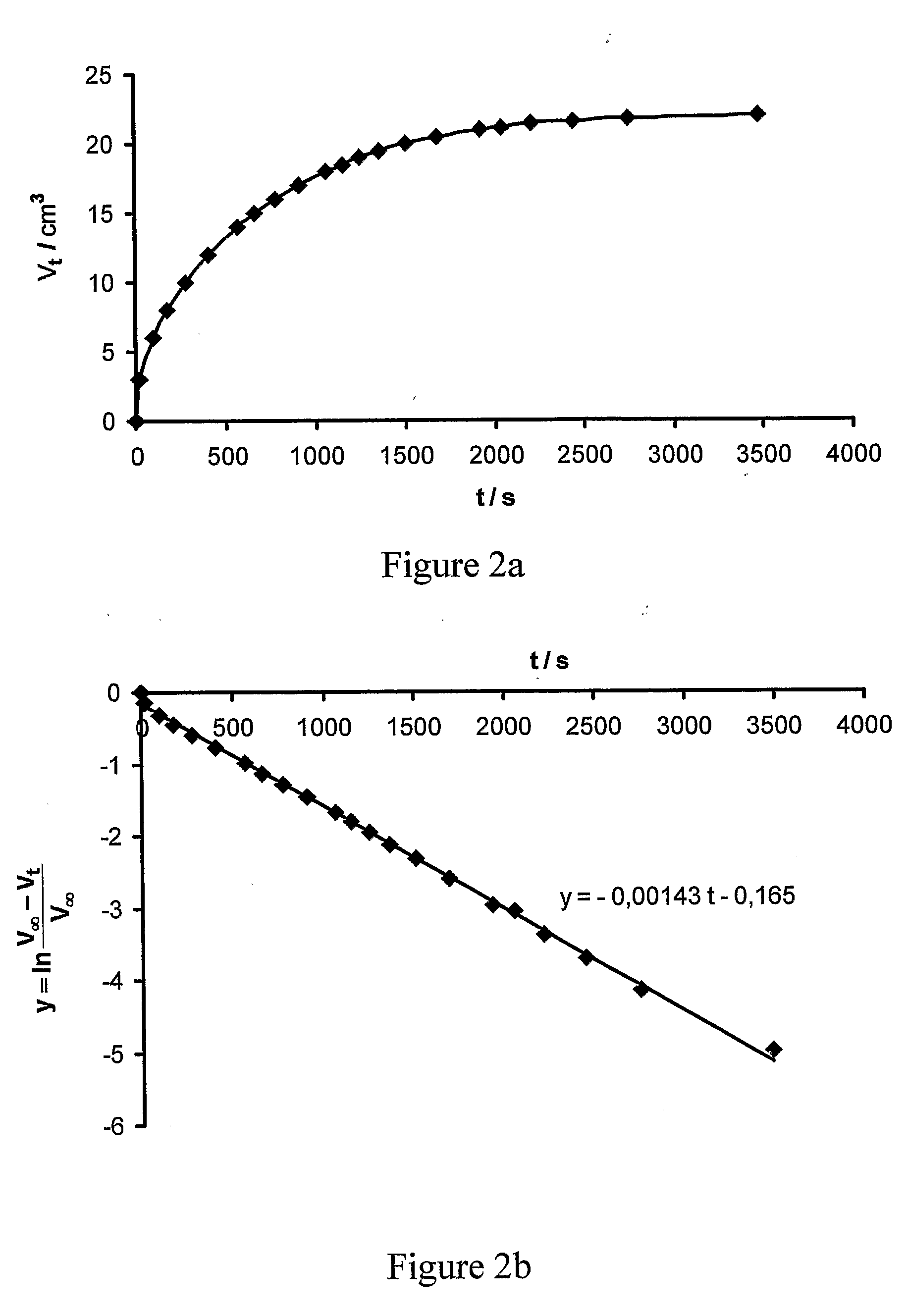Permeation method and apparatus for preparing fluids containing high purity chlorine dioxide
a technology of chlorine dioxide and permeation method, which is applied in the direction of inorganic chemistry, gas generation devices, membranes, etc., can solve the problems of affecting the health of people, affecting the operation of reactors, and achieving critical concentrations that are more difficult to achieve, so as to facilitate the construction of reactors and simple equipment
- Summary
- Abstract
- Description
- Claims
- Application Information
AI Technical Summary
Benefits of technology
Problems solved by technology
Method used
Image
Examples
example 1
Tubular Reactor with Permeable Walls and a Batch Method to Prepare Aqueous Chlorine Dioxide Solution
[0129]According to this method the reactor shown on FIG. 3a) can be filled up e.g. with the double syringe shown on FIG. 3b). Syringe 35 containing the NaClO2 solution and syringe 36 containing the acidic solution were inserted into device 37 only after filling them with the reagents. The two solutions can be pushed simultaneously with the device shown on FIG. 3b) into the silicon rubber tube 31 with a length of 7 m, inner diameter 1 mm, outer diameter 2 mm. While flowing in, the reagents are mixed at the beginning of the common tube section 38. After filling it up, the two ends of the silicon rubber tube were closed with a PVC tube section 32. The silicon rubber tube was immersed into the glass bottle 33 containing 0.5 l distilled water as shown on FIG. 3a). The water was stirred with a magnetic stirrer bar 34. The chlorine dioxide evolving inside the silicon rubber tube permeated in...
example 2
Countercurrent Tubular Reactor with Permeable Walls and a Continuous Method to Produce Chlorine Dioxide—Containing Gas or Water Streams
[0153]The device can be designed based on point D) of Example 1. (henceforth: Experiment D)). As shown in FIG. 5. the two solutions are pumped by two peristaltic pumps 51 and 52 continuously into the core of the silicon rubber tube 53 around which water or air is kept flowing by pump 54. The endproduct—the fluid (water or air) saturated with ClO2—leaves the reactor at vent 55 while the exhausted reagents are collected in tank 56. The silicon rubber permeation reactor 53 has a length of 7 m, inner diameter 1 mm and outer diameter 2 mm. (This is the same tube that was applied in Experiment D).) As, according to our experiments, the time needed to reach maximal conversion is at least 12 min and the inner cubic capacity of the tube is 5.5 cm3, the maximum value of the flow rate in the tube can be 0.46 cm3 / min. This means that both solution I. (an aqueous...
example 3
A Micro-Reactor Applying a Flat Silicone Rubber Membrane and Hydrogel Embedded Reagents to Establish a Slow Focused Chlorine Dioxide Input of Small Quanta
[0155]In examples 1. and 2. we have presented devices which can be used for the production of chlorine dioxide-containing water or air. These fluids containing pure chlorine dioxide can be used to flood places where we need e.g. the biocid effect of chlorine dioxide. Anyway, it can happen that we want to apply chlorine dioxide not in a great quantity, homogeneously spread in a big space but only in minute quantities, focussed on a limited area. In this case our intention is to construct a disposable, small reactor which can be used also by a non-professional person easily, without any risk. FIG. 6. shows such a micro-reactor.
[0156]FIG. 6.a) shows the cross-sectional view of the micro-reactor. The bottom of the reactor is the disk 61 made of a textile reinforced silicon rubber membrane with a thickness of 0.3 mm and diameter of 18 m...
PUM
| Property | Measurement | Unit |
|---|---|---|
| thickness | aaaaa | aaaaa |
| distribution coefficient | aaaaa | aaaaa |
| molar ratio | aaaaa | aaaaa |
Abstract
Description
Claims
Application Information
 Login to View More
Login to View More - R&D
- Intellectual Property
- Life Sciences
- Materials
- Tech Scout
- Unparalleled Data Quality
- Higher Quality Content
- 60% Fewer Hallucinations
Browse by: Latest US Patents, China's latest patents, Technical Efficacy Thesaurus, Application Domain, Technology Topic, Popular Technical Reports.
© 2025 PatSnap. All rights reserved.Legal|Privacy policy|Modern Slavery Act Transparency Statement|Sitemap|About US| Contact US: help@patsnap.com



